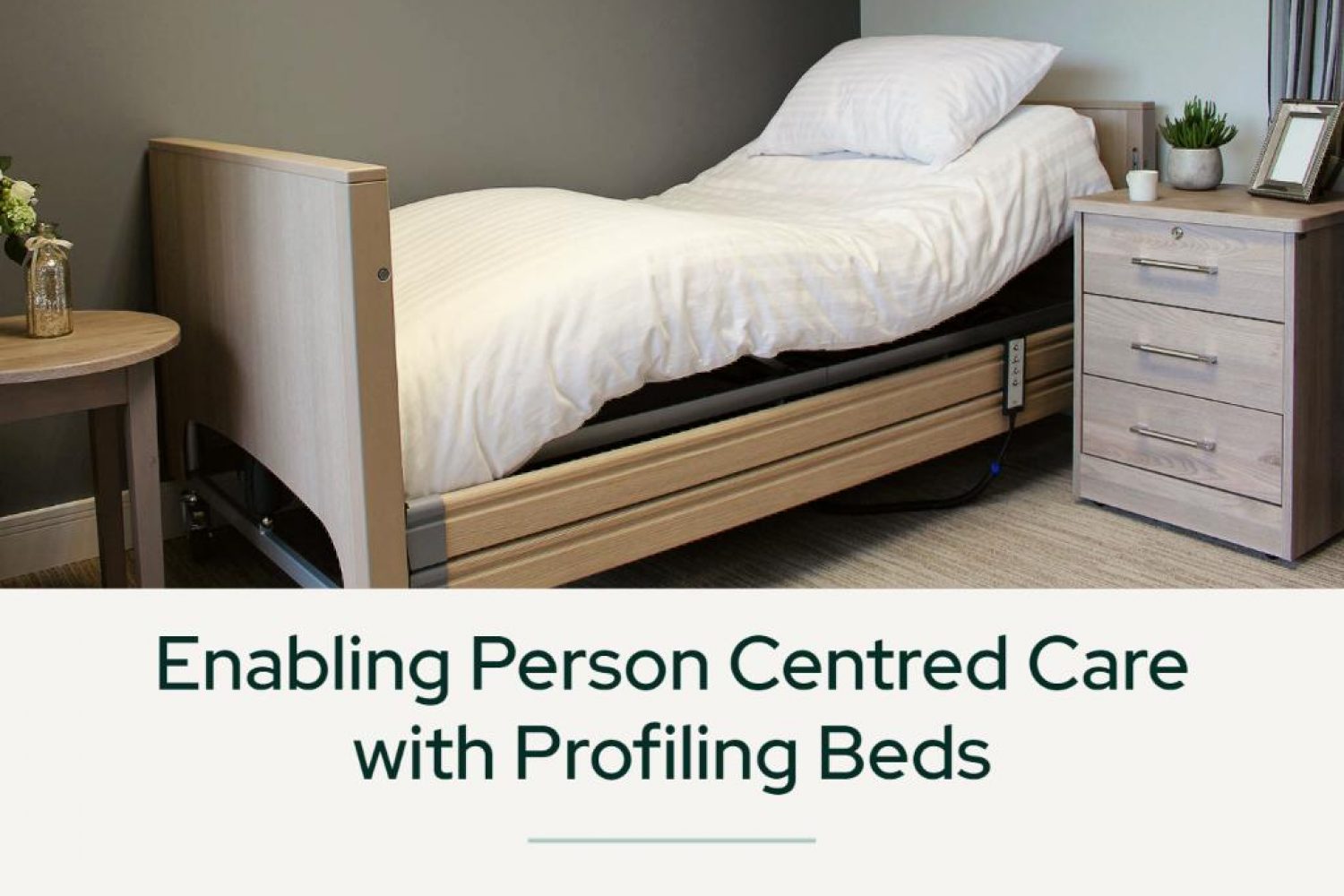- Article
- Mike Goldwater
Hi I’m Mike Goldwater and I was at the photoshoot for the new Furncare Liv Collection of bedrooms and communal rooms for challenging environments and those living with disability or dementia. Having spent some

Need to purchase profiling care beds? Skip to our product page. Browse Beds>>.
So, you may be thinking, how did Person Centred Care and Profiling Care Beds end up in the same article. Here’s how…
Firstly, what is person-centred care? Person-centred care is a holistic approach to healthcare that focuses on the needs and preferences of the individual patient. It cannot exactly be concisely explained with a few simple words, as there are many aspects to consider. It would be more accurately described as a concept, or an ideology.
According to the Health Foundation, there are four principles that make up Person Centred Care:
This approach is designed to empower patients to take control of their own care and to make informed decisions about their treatment options.
As each resident or service user’s needs differ, each of the four principles will carry different weight and should be considered accordingly. For example, with care regarding a patient who is has less physical or mental capacity, there might more emphasis on care that preserves the user’s dignity.
So how does this relate to profiling beds?
A common misconception about profiling beds it that they are only used in elderly care settings. Profiling beds are an integral feature of many domestic and commercial care home settings and in mental health and learning disability homes. They are even often used in domestic settings where there is no particular care requirement. This being said, many care environments are only outfitted with equipment that is ‘necessary’ and profiling beds are still often seen as a luxury or non-essential. While profiling beds are more expensive than a standard box bed or a divan bed, profiling beds allow carers to give residents and service users a higher level of care.
The question is: Could an industry wide take-up of profiling beds transform person-centred care?
To answer this question, we need to know more about profiling beds. Many of you reading this article are probably well aware of what profiling beds are, but for those that are less familiar, here is a quick overview. Profiling beds can have up to four sections to create “profiles” – hence their name. This allows users and carers to create a profile that perfectly suits the particular user’s needs. Raising the head and/or the foot of the bed for both comfort and support is just the beginning. Some beds are powered with powerful and reliable motors, allowing easy and non-intrusive adjustments to the bed.
While it may seem obvious to some, there are many different ways to utilise a profiling bed to its full capacity. Firstly, we will cover the main positions and when to use them. There are 4 main sleeping positions that can be adopted to suit the needs of the resident.
 “Zero Gravity”. This position was originally discovered by astronauts, hence the name ‘zero gravity’. The head of the bed is raised to around 15 degrees and the foot of the bed raised to around the same height. The hips are slightly lower than both the head and feet resulting in reduced pressure on joints, nerves and organs. It is also known for reducing pressure on the sciatic nerve, reducing sciatica pain.
“Zero Gravity”. This position was originally discovered by astronauts, hence the name ‘zero gravity’. The head of the bed is raised to around 15 degrees and the foot of the bed raised to around the same height. The hips are slightly lower than both the head and feet resulting in reduced pressure on joints, nerves and organs. It is also known for reducing pressure on the sciatic nerve, reducing sciatica pain.
 “Feet Raised”. This position heightens the foot position, perfect for those suffering with heart or blood pressure problems. This position is often used by medical professionals after a patient has suffered a heart issue or has undergone heart surgery to relieve pressure on the heart.
“Feet Raised”. This position heightens the foot position, perfect for those suffering with heart or blood pressure problems. This position is often used by medical professionals after a patient has suffered a heart issue or has undergone heart surgery to relieve pressure on the heart.
 “Head Raised”. This position is often used for residents who have breathing problems or chest conditions. Even if a service user catches a cold or chesty cough, this position can be adopted to aid clearing of the lungs and windpipe.
“Head Raised”. This position is often used for residents who have breathing problems or chest conditions. Even if a service user catches a cold or chesty cough, this position can be adopted to aid clearing of the lungs and windpipe.
 “Feet and Head Raised”. This position is a happy medium between positions 2 and 3. When raising the feet, some users experience pressure on the chest area, and raising the head can help tackle this issue.
“Feet and Head Raised”. This position is a happy medium between positions 2 and 3. When raising the feet, some users experience pressure on the chest area, and raising the head can help tackle this issue.
When using any of the positions listed above, always consider the comfort of each user. Adjustments to these positions should be made until the resident is comfortable and feels safe.
When used correctly, profiling beds provide a whole host of fantastic benefits for the user, which can be invaluable for those with mobility and health issues. The four sleeping positions listed previously impact positively on health and can help with recovery from illness and injuries.
Profiling beds maximise user independence and safety, particularly with getting in and out of bed. Being able to raise or lower the bed to the perfect position, where the user can easily and safely get up off the bed, greatly increases the user’s independence and drastically reduces the chance of falls.
For individuals whose conditions mean they need to spend a substantial proportion of their time in bed, profiling beds provide a safe and comfortable environment for them. Spending a long time in bed can lead to developing pressure sores. Adopting certain bed positions can help equally distribute pressure, leading to a lower chance of the user developing pressure sores.
As previously mentioned earlier the “Zero Gravity” position is an optimal position for pain relief and pressure relief on joints and nerves. The head and feet are raised just slightly higher than the hips, mimicking the shape of the recovery position. It means the body’s weight is evenly distributed across the bed, leading to less pressure on affected joints, relaxed muscles and decompressed spinal vertebrae. As it sounds somewhat astronautical, you may not be too surprised to learn that it was coined by NASA. The health benefits are manifold: increased blood circulation, improved relaxation, better breathing and reduced obstructive sleep apnoea. This position can also alleviate back and neck pains, reduce the symptoms of asthma, mitigate against acid reflux and heartburns, as well as improving blood flow.
“Feet Raised” is the position where the mattress lays flat, but the foot section is raised. This sleeping and resting profile reduces pressure on the heart as it can move blood to the vital organs much easier. It helps with blood pressure, can reduce inflammation, reduce the chance of DVT (deep vein thrombosis) and enhance comfort. Back pain can be relieved and spine alignment improved by using a ‘feet raised’ position on a profiling bed.
Using a “Head Raised” position can assist with users who have breathing difficulties or chest conditions. It reduces the pressure on the chest area, helping with breathing, and assist with pain relief from issues like spinal problems. Assuming this position can also be used if a user contracts a cold or chesty cough. Raising the chest helps to clear any congestion and maintain clear airways.
When using the ‘Feet raised position’, many users can experience a feeling of pressure on the chest. Adopting the “Feet and Head Raised” is a happy medium and perfect for reducing breathing issues, as well as solving some of the issues associated with sleep apnoea. This position can be used when the Zero Gravity profile isn’t an option, or if the user finds it uncomfortable.
While electric profiling beds may be more expensive than manually operated profiling beds, there are many benefits to both the user and care staff. Electric profiling beds help carers and assistants, who need not rely on strength to move the user. This makes their lives safer and easier, thus reducing the risk of injury to bed occupants, and care staff. This can also preserve the dignity of the service user, as the amount of manual handling required by care staff is significantly reduced.
Despite the many benefits of profiling beds, there are also some challenges associated with their use. One of the main challenges is the cost of these beds, which can be quite high. This can make it particularly difficult for smaller healthcare providers to purchase and maintain a sufficient number of profiling beds to meet the needs of their patients. The cost of running and maintaining them also should be considered. With the current cost of electricity, switching over to electric profiling beds can have an impact on your overheads. The impact, however, should be fairly insignificant as most beds use highly efficient motors and only use power when being raised, lowered, or adjusted.
Another challenge is the need for staff training to use the beds properly. Some profiling beds can be complex and require a certain level of knowledge and skill to operate effectively. This can make it difficult for healthcare providers to ensure that staff are properly trained and able to use the beds safely and effectively.
To conclude…
As we know, the four principles of person-centred care are:
Profiling beds can assist with all four of the aforementioned points. They help in affording dignity, compassion, and respect through reducing the amount of manual handling and users’ dependability on care staff. They help care providers with coordinated and personalised care support and treatment. And they help people to maximise their independence, develop their strengths and abilities, which in turn provides a means for them to live a fulfilling and good quality life.
In conclusion, profiling beds are an essential tool for delivering person-centred care. They can be adjusted to meet the specific needs of each patient, helping to improve the overall comfort, quality of care and reduce the risk of complications and health issues. They are particularly important for patients who have mobility issues, and they are able to provide the necessary support and stability for them, reducing the chance of falls. Profiling beds can be adjusted to provide pressure relief for patients who are at risk of developing pressure ulcers, this can help to reduce the risk of these serious and painful conditions, which can have a significant effect on the overall quality of life of the people receiving care.
So, the answer to our question: “Could an industry wide take-up of profiling beds transform person-centred care?” has to be a resounding “Yes!”
Credits and Sources:
Person centred care: https://www.health.org.uk/publications/person-centred-care-made-simple
HSE recommendations on profiling beds: https://www.hse.gov.uk/healthservices/epb-health-care.pdf
| Cookie | Duration | Description |
|---|---|---|
| cookielawinfo-checkbox-analytics | 11 months | This cookie is set by GDPR Cookie Consent plugin. The cookie is used to store the user consent for the cookies in the category "Analytics". |
| cookielawinfo-checkbox-functional | 11 months | The cookie is set by GDPR cookie consent to record the user consent for the cookies in the category "Functional". |
| cookielawinfo-checkbox-necessary | 11 months | This cookie is set by GDPR Cookie Consent plugin. The cookies is used to store the user consent for the cookies in the category "Necessary". |
| cookielawinfo-checkbox-others | 11 months | This cookie is set by GDPR Cookie Consent plugin. The cookie is used to store the user consent for the cookies in the category "Other. |
| cookielawinfo-checkbox-performance | 11 months | This cookie is set by GDPR Cookie Consent plugin. The cookie is used to store the user consent for the cookies in the category "Performance". |
| viewed_cookie_policy | 11 months | The cookie is set by the GDPR Cookie Consent plugin and is used to store whether or not user has consented to the use of cookies. It does not store any personal data. |